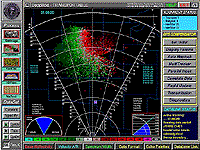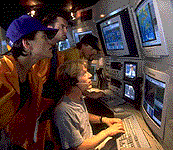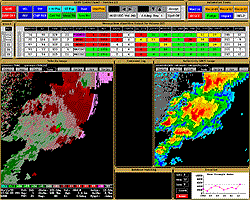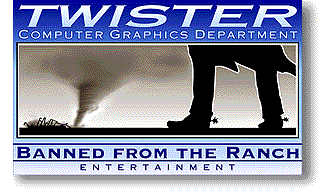About Our Work
Jan DeBont's man vs. nature summer blockbuster features scores of BFTR's high-resolution computer graphics and video displays to create the high-tech tools of the stormchaser trade. BFTR's design and playback team spent four months on location with the production in Oklahoma and Iowa, researching meteorology, creating graphics for two different stormchasing teams, and generally subjecting many a real computer to grueling punishment from the heat, the rain and the director.
Never has computer technology been put through so much "adverse condition testing" as on this film. With SGI product placement of dozens of Indigo II Extremes and Indys, BFTR set out to create fully accurate, "wish-list" meteorological computer screens... and ended up being one of the few departmental survivors of the most chaotic maelstrom ever to hit the Midwest: the filming of a Jan DeBont movie.
Determined to create displays that were as realistic as possible for the few stormchasers and meteorologists who might take the film seriously, Van traveled to the National Severe Storms Laboratory (NSSL) in Norman, Oklahoma, where meteorologists Kevin Kelleher and Philip Bothwell gave him a crash course in the scientific yet intuition-based field. Armed with actual NSSL storm data from previous tornado outbreaks, Earthwatch and NOAA weather visualization software, and the assistance of both Earthwatch's Paul Douglas and the production's meteorological consultant Vince Miller, Van would eventually create scores of high-resolution animations, most of them in his hotel room during the shoot. Again, the displays not only had to stand in for the tornadoes in the film, both seen and unseen, but also had to play a crucial part in the climax of the film, indicating that the stormchasers have succeeded in their quest to put their probe Dorothy into the heart of the twister. The 3D tornado data at the climax of the film was created using Wavefront's Dynamation, which was the same program used by ILM to create the visual effects tornadoes.
 The show's weather-dependent and thus ever-changing shoot schedule dictated that the graphics for any given scene be ready for shooting with usually only eight hours' notice, we had to be flexible and prepared. As such, Van had his hotel room wired up with a PowerMac and three to four SGI systems, where he could work constantly on the graphics before sending them to set via hard drive or DAT tape. None of the hotels/motels we stayed in were designed for this kind of thing, of course, so in the longer-term stays (a month or more), we had the power beefed up in the rooms. Virtually all of the animations were designed and created on the Mac using Adobe Photoshop, Macromedia Director and ElectricImage, then ported to the SGI and assembled using a myriad of existing and custom graphics software. In a few cases, we modified and then built graphic shells around real weather software, but in most cases we had to take the real data, run it through the real programs, then screen-grab the data frame by frame in order to incorporate it into an animation. The one big concession to dramatic license in terms of the graphics was its speed; meteorologists can only dream of the kind of fully realtime Doppler radar display interfaces we created (although they are all technically feasible, just way too expensive). The best testament to our work was that when we showed our graphics screens to the folks at NSSL, they immediately started to try to use the fake interfaces as if they were real!
The show's weather-dependent and thus ever-changing shoot schedule dictated that the graphics for any given scene be ready for shooting with usually only eight hours' notice, we had to be flexible and prepared. As such, Van had his hotel room wired up with a PowerMac and three to four SGI systems, where he could work constantly on the graphics before sending them to set via hard drive or DAT tape. None of the hotels/motels we stayed in were designed for this kind of thing, of course, so in the longer-term stays (a month or more), we had the power beefed up in the rooms. Virtually all of the animations were designed and created on the Mac using Adobe Photoshop, Macromedia Director and ElectricImage, then ported to the SGI and assembled using a myriad of existing and custom graphics software. In a few cases, we modified and then built graphic shells around real weather software, but in most cases we had to take the real data, run it through the real programs, then screen-grab the data frame by frame in order to incorporate it into an animation. The one big concession to dramatic license in terms of the graphics was its speed; meteorologists can only dream of the kind of fully realtime Doppler radar display interfaces we created (although they are all technically feasible, just way too expensive). The best testament to our work was that when we showed our graphics screens to the folks at NSSL, they immediately started to try to use the fake interfaces as if they were real!
 Apart from the graphics themselves, the on-set playback team, led by tech supervisor Josh Kirschenbaum, had their work cut out for them; nearly all of the work was on ever-changing locations, and many of the scenes took place in moving vehicles that had to be rigged up for anywhere between two to ten computers and video monitors. These vehicles often sat all day in the broiling sun or pouring rain, with mud and dust getting into everything; in addition, there were several different sets of each vehicle and not enough computer equipment for all of them, so we would often have to schlepp systems between them. Driving them over bumpy dirt roads and in stunt turns didn't help, either. A word to all computer users: don't try this at home. To facilitate the on-set work, BFTR rented a Ryder cube van and outfitted it with shelves and desks so that even more fine-tuning could be done on location as necessary.
Apart from the graphics themselves, the on-set playback team, led by tech supervisor Josh Kirschenbaum, had their work cut out for them; nearly all of the work was on ever-changing locations, and many of the scenes took place in moving vehicles that had to be rigged up for anywhere between two to ten computers and video monitors. These vehicles often sat all day in the broiling sun or pouring rain, with mud and dust getting into everything; in addition, there were several different sets of each vehicle and not enough computer equipment for all of them, so we would often have to schlepp systems between them. Driving them over bumpy dirt roads and in stunt turns didn't help, either. A word to all computer users: don't try this at home. To facilitate the on-set work, BFTR rented a Ryder cube van and outfitted it with shelves and desks so that even more fine-tuning could be done on location as necessary.
Since a custom common sync signal had to be run to each computer and monitor --and to each camera-- in order to get a good image on film, we were constantly scrambling to hook things up. For example, one night scene that took place in the demolished neighborhood of Wakita had several monitors in Dusty's bus visible in the shot, and Jan wanted to have a dollied camera pull back around from seeing the screens and look at the inside of the ambulance. We rigged it all up with a long cable running sync to the camera, no problem. Then Jan added a second camera, a Steadicam, which sent us scrambling to run a sync cable to it, without the cable being seen by the other camera. Then he added a third camera, which was going to follow the ambulance as it pulled away --running over the sync cables to the first two cameras! This was a typical challenge.
Our biggest playback set was the NSSL set, which was a thirty-screen affair built in an empty barn warehouse with fluctuating power and portable air conditioning which had to be turned off during takes in order to get clean sound. We had a Hughes-JVC video/data projector putting an image on a six-foot screen, with the laptop LCD screens mounted behind holes in the wall to add more screens.
In the story, the two rival chase teams --one corporate sponsored, one low-tech university funded-- both have sets of computer equipment that was to match their incomes. SGI product placement dictated that ALL of the computers in the film had to be SGIs, so we had the task of making not only two distinctly different sets of graphics for nearly every scene, but different-looking EQUIPMENT between the two teams. This was nowhere more evident than with the SGI "laptops," which of course didn't exist. With the tireless dedication and help of Dan Evanicky at SGI, we were able to design and build two different fake laptop shells around the SGI Corona LCD flatscreen displays, with seven functional and seven dummy cases for each design, we had a handful to take care of; each "laptop" had a powerful custom backlight run off a separate 12-volt DC power supply and multiple cables which ran back off the set (often through mud and puddles) to the Indy CPUs which fed them. Each shell was custom-milled for us by IDE, a prototype manufacturer in the Silicon Valley.
 BFTR was responsible not only for the computer displays that play important parts in the story, but also for the various weather newscasts and videos seen throughout the film. For the newscasts, we were able in pre-production to go to each of the three major local television stations in Oklahoma and have the real anchors "perform" the newscasts for the scripted storm events. All of this video material was shot on Betacam SP and edited together with our own custom graphics by video editor Wes Rubinstein, who had the BFTR Avid set up in one of our hotel rooms. As we were also responsible for playing back the various music videos on the set in Dusty's bus, we had an ADAC (barely) portable realtime 30fps-to-24fps video converter with us for the entire shoot.
BFTR was responsible not only for the computer displays that play important parts in the story, but also for the various weather newscasts and videos seen throughout the film. For the newscasts, we were able in pre-production to go to each of the three major local television stations in Oklahoma and have the real anchors "perform" the newscasts for the scripted storm events. All of this video material was shot on Betacam SP and edited together with our own custom graphics by video editor Wes Rubinstein, who had the BFTR Avid set up in one of our hotel rooms. As we were also responsible for playing back the various music videos on the set in Dusty's bus, we had an ADAC (barely) portable realtime 30fps-to-24fps video converter with us for the entire shoot.
Often, we wouldn't get a decision on which of the dozen different music videos Jan might want to use in the scene, so we had to prepare and convert them all; in one instance, we were given a CD of Deep Purple's "Child in Time" --one of Jan's favorites-- and a tape of Deep Purple concert footage (in which of
course, they DON'T sing that particular song), and were told to cut a music video together! BFTR producer Casey Cannon drew upon her own strong musical background to do the edit, which played briefly in the fast food joint in the drive-in sequence.
TWISTER was the first real trial by storm for BFTR, a full-scale location show featuring on-set video and graphics playback, often in broad daylight, with every possible challenge. Sweltering heat creating fatal bus errors in the CPUs. Lightning storms threatening to send surges through the hotel AC power and fry the machines and possibly their operators. Actors using the laptops as head protection from the hail. Scripts were razed. Dialogue was blown away. Departments fell. Schedules collapsed. Tempers imploded and exploded. And the graphics played on and on...
Our Credits

TWISTER
Computer Graphics and On-Set Playback by
BANNED FROM THE RANCH ENTERTAINMENT |
|
Computer Graphics Supervisor
VAN LING
Computer Graphics Producer
CASEY CANNON
Technical Supervisor
JOSH KIRSCHENBAUM
|
Production Manager
JOSEPH "J.M." KENNY
Video Editor
WES M. RUBINSTEIN
SGI Flatpanel Consultant
DAN EVANICKY
|
On-Set Technicians
GLENN CANNON
SHYAM V. YADAV
PAUL GIBILISCO
BFTR Staff
GAIL WISE
LAURYL DUPLECHAN
|
Special Thanks To:
Sean Yamamoto, Paul Douglas, Lisa Cheney, Ashley Mooser, Kevin Kelleher, Philip Bothwell, Cyrus Smith, Matt Hoffman, Jay Roth, Joe Nemec III, Joe Kane, Ron Williams, etc.
|
|

Banned From The Ranch Entertainment Home Page
����General Information: info@bftr.com